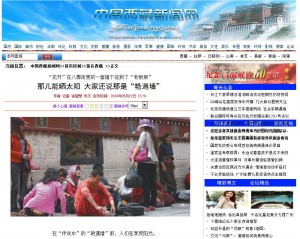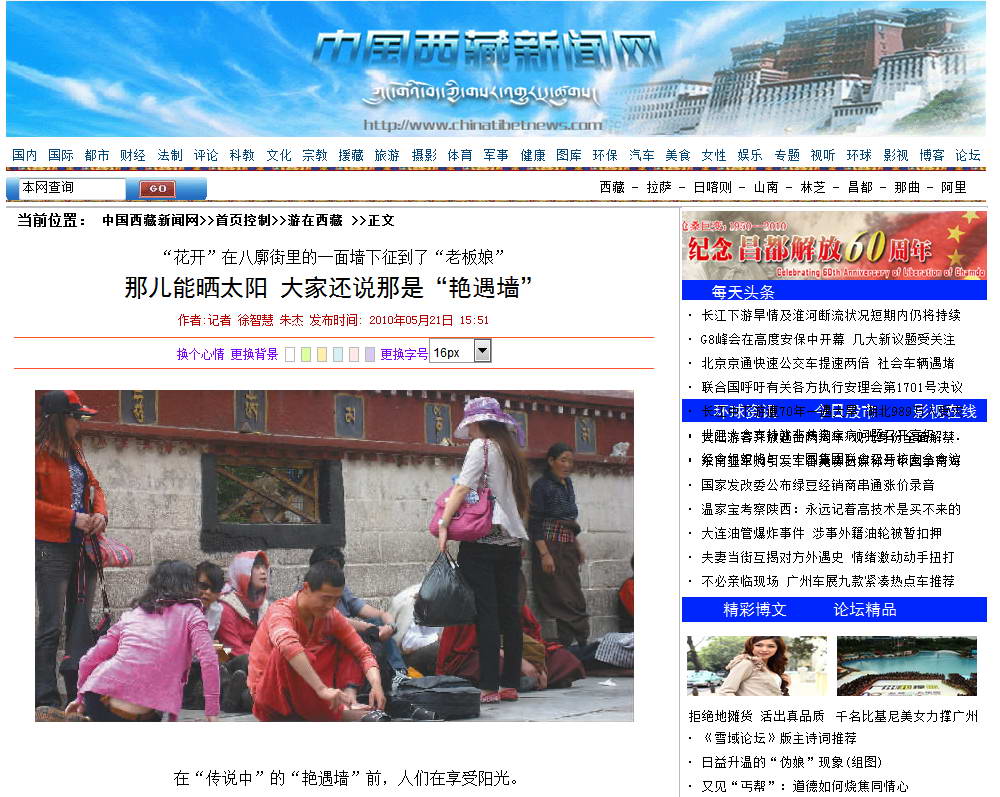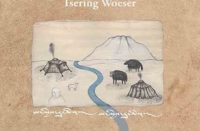High Peaks Pure Earth has translated a blogpost by Woeser written on May 9, 2011 for the Tibetan service of Radio Free Asia and posted on her blog on May 27, 2011.
In this blogpost, Woeser criticises a TV programme shown on Tibet TV that glorifies a place that has come to be known as Lhasa’s “Romance Wall”. The “Romance Wall” may be an unfamiliar term to us but the spot is increasingly becoming a tourist attraction for Chinese tourists to Tibet. For readers who understand Chinese, the TV programme “Travel Tibet” that goes on the search for this “Romance Wall” can be viewed here on YouTube.
This is not the first time that Woeser has written about Chinese tourists and travellers in Tibet, there are similar themes in last years’s blogpost “Who Is Really Safeguarding Lhasa” For other Tibetan bloggers’ views on Chinese tourists in Tibet, re-visit our two translations in the blogpost “Fish Speaking Back to Ichthyologists”.
Finally, for those readers who feel compelled to rush to Lhasa to experience the “Romance Wall”, there is bad news, Tibet is closed to foreign travellers until the end of July.

The advertisement for the programme “Travel Tibet”, broadcast during primetime on Tibet TV tells us: “We are constantly striving for the promotion of travel in the Western provinces and mysterious Tibetan culture”, yet, when I watched the latest episode I felt disgusted as though I had just swallowed a fly. The Tibetan host and the journalist excitedly introduced Lhasa’s “Romance Wall”; they even interviewed some Han Chinese tourists sitting around the wall who expressed their respect for the pilgrims prostrating in the area.
The term “Romance Wall” first appeared on the internet a few years ago. Some people who had travelled to Tibet, as well as those who had lived in Lhasa for some time, bragged about inventing that term and posted various photos of themselves crowding around the wall. Subsequently, this caught the media’s attention, which resulted in tourists swarming into Tibet, blindly searching for something unobtainable. The so-called “Romance Wall” is situated opposite Jokhang Temple, which originally served as a place for pilgrims to offer thousands of butter lamps in small cups and as a place for those prostrating to take a rest. But after it was transformed into the “Romance Wall”, it was often occupied by tourists looking for a slice of “romance” and the pilgrims had no choice but to cramp together, standing back to back when prostrating.
I have seen those tourists squeezed at the bottom of the wall many times; they nestle, smoke, drink beer, laugh noisily, feed each other or lift their enormous cameras, scrupulously taking photos of the prostrating pilgrims. Some place a sign in front of their chests, writing that they are looking for a mistress or are recruiting partners etc. Some are disguised as beggars with a paper box or hat placed in front of them they shout “please, please” at the Tibetan pilgrims. Others suddenly throw themselves to the ground, imitating the prostrating of Tibetan pilgrims in a derisive way. A tourist who had visited the “Romance Wall” many times wrote online: “We sit at the bottom of the wall, smoke and laugh at these people. We don’t understand their beliefs. We don’t know what they are after. Afterlife?”
There is nothing more vulgar than the expression “Romance Wall”. Tibet has never had any “Romance Wall”. The Butter Lamp shrine opposite Jokhang Temple was only established in the mid-1990s and the many adult Tibetan pilgrims who have been prostrating in its vicinity for many years come from all over Tibet. Many left their far-away hometowns to embark on the long road of pilgrimage and only reach Lhasa after countless days; this resembles Muslims going to Mecca or Catholics going to the Vatican to pray. But today, their pilgrimage is being obstructed. Those romance and novelty seeking tourists who drive the pilgrims into a corner have completely changed the atmosphere of the place. A Tibetan online friend said: “In today’s world, only the charitable Buddhist beliefs can really tolerate the wanton behaviour of these people in sacred places; who would dare to smoke cigarettes and drink beer next to the Ka’aba in Mecca?!”
This vulgarity has even won over the media’s support. If one searches for “Romance Wall”, one obtains results such as “Lhasa’s Romance Wall” or “Jokhang Temple’s Romance Wall”. Chinese media such as Xinhua News, Tibet News Online, Tibet Business News use exaggerated and embellished headlines such as “‘Romance Wall’ in the Barkhor or Lhasa’s ‘Romance Wall’: places where it is easiest to have an encounter with beautiful women”. Today, Tibet TV once more prosperously recommends the “Romance Wall” in its travel programme directed at Han Chinese tourists. One can already foresee that with the media hype, this already emerging tourist spot will be brimming with luring stories and every travel brochure, every travel map will tag it; travel agencies, tour guides and hotels of all sizes will treat it as an attraction, hereby turning it into a “tourist colony”; the “Romance Wall” will go the way of Sun Island, Potala Palace Square or the Dragon King Pond, and become one of Lhasa’s prominent landmarks.
Beijing, May 9, 2011





What's up with the Chinese affinity with walls? Romance Wall should be renamed Silly Tourist Wall
China is ashamed of their THEIR FIREWALL so introducing THE ROMANCE WALL………. to fool the tourists.
It is indeed a deliberate act of China in undermining Tibet's faith and religious belief by establishing a Romance Wall with the vicinity of Jokhang Temple. Not only that, Chinese government and medias are encouraging their fools to visit the Romance Wall to to promote tourism, as it is one of the pillars of so called 'Development' of Tibet. It is such an absurdity yet a fact in showing how China truly protects Religious freedom in Tibet.